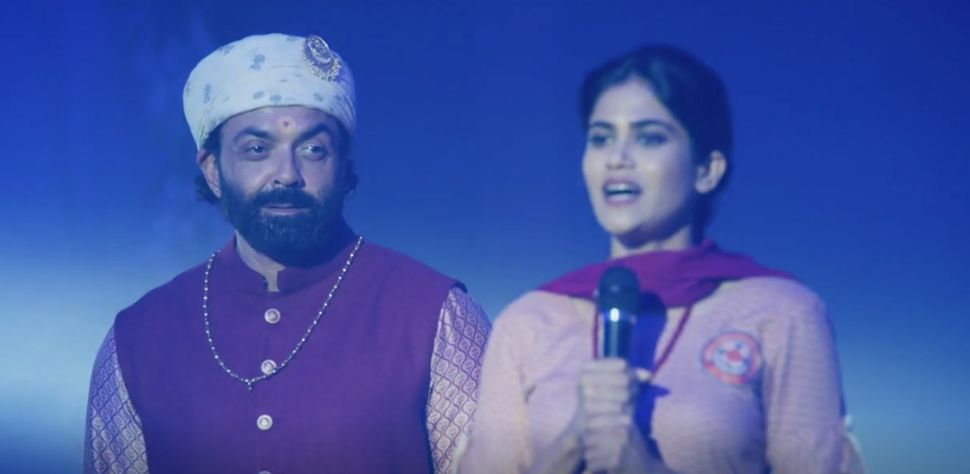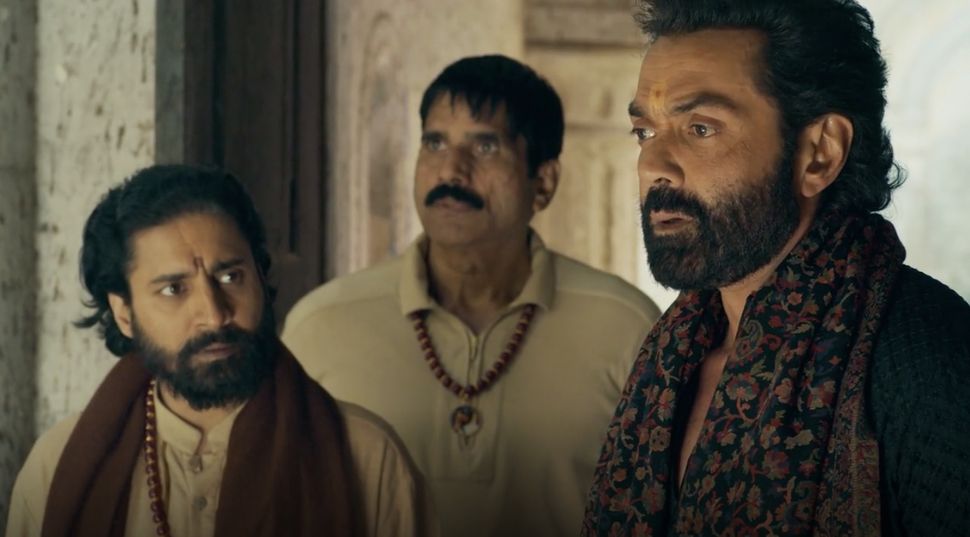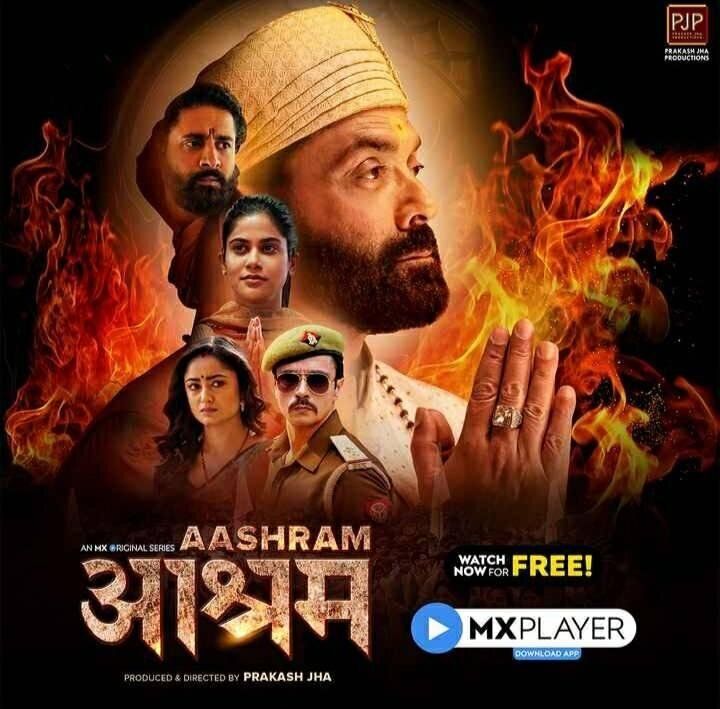
In one of Aashram’s most significant scenes, a marriage procession of a Dalit man has arrived at the gates of a dominant caste colony. The groom is on a white, decked-up horse. The elders of his family gently coax him to get off the horse: “Get off the horse now. Once we have crossed the upper caste colony, you can get on it again.” Others shush the dhols being played by the younger men and women. A group of smug, dominant caste men meet the procession and ask the people to keep playing the dhol and dance. The younger, hopeful Dalit men and women erupt in glee, but the older men are still sort of frozen with suspicion. And their fears come true — soon, a bunch of dominant caste men start harassing the women in the procession. As the women protest, the savarna men swoop down on the procession, clobbering the men with lathis and butts of guns, kicking and slapping them, pushing and dragging the women — it’s almost a picnic of violence.
From a production point of view, the scene is mediocre at best. Most of the actors come across as wooden, their dialogue delivery is almost robotic at times and the lines are melodramatic. Yet, it is perhaps the only scene in recent memory that I have watched in a Hindi film or OTT show that shows, fairly unhesitantly, how dominant castes treat violence as a recreational sport, and treat basic rights in a democracy as trophies they like snatching from Dalit Bahujan people.
The opening section from Aashram’s first season was “inspired” by the real-life incident of a Dalit man who was beaten up for riding a horse to his wedding. Aashram is a loosely tied string of several such incidents, but the central premise is critical of the majoritarian Hindutva politics dominating the country at present. However, its rhetoric is very 90s drama, and the preachiness blocks out any hope of nuance. As a result, the series’ treatment of caste-based discrimination and violence is heavy-handed. Significantly, the main cast doesn’t include Dalit, Bahujan or Adivasi actors, raising the question of whether the makers really care about walking their talk.

That said, at a time the government is actively attempting to regulate creative content, the two seasons of Aashram — which talk about violence by dominant castes and sexual abuse in cults mirroring practices of Hinduism — stand out for their intent, if not the execution.
In the first few episodes of season 1, Aashram also challenges the recurrent, uninformed savarna argument that the Dalit and Bahujan community don’t work hard enough or lack merit. Pammi, the protagonist of Aashram, is a young Dalit wrestler who dreams of becoming a national champion and turning around the fortunes of her poor family. Her family, the series shows, puts their little money into training her and yet, at competitions, dominant caste contestants who have lost to her are declared winners. Though the dialogues in this section are sweeping and theatrical, they lay bare how the dominant caste nexus actively prevents marginalised castes from accessing basic education and progress, no matter how hard they work.
Aashram’s storyline, in the first season, has two threads. One follows Pammi (played by Aditi Pohankar) as she rages against dominant castes who constantly thwart her dreams of becoming a national wrestling champion and how she finds herself caught in the hogwash of a cult built by a crook who calls himself Baba Nirala. The other unravels how the ‘baba’ is not who he seems like but has a dark, shady past zealously guarded by his murderous accomplices.
Pammi is ‘rescued’ from the violence of the dominant castes by Baba Nirala (played by Bobby Deol) and his men and soon, the family find themselves in his aashram, sacrificing all they have at his altar. Meanwhile, there are telltale signs of sexual abuse in the aashram, which is covered up by goons. This season stands its ground on the nature of caste atrocities and how they thrive. From police refusing to file an FIR against dominant caste goons to local politicians manipulating contests and then violently rejecting the rightful claims of Dalits, in the first few episodes, Aashram’s focus on the unscrupulous cruelty of the upper castes is unwavering.

Considering that MX Player, unlike Netflix, is made for widespread consumption and Aashram can be viewed for free, Prakash Jha doesn’t even have the flimsy protection that comes with being ‘niche’. The grandiose dialogues, clanging soundscape and overwrought drama amplify the caste nexus that most of Hindu right-wing social media is eager to brush off as non-existent. At a time when movie names have had to be changed because of fear of the right-wing, the fact that Aashram pulls no punches in showing a revered ‘baba’ as a sexual predator is worth taking note of. In most of its first season, Jha’s Aashram wades into waters big Bollywood producers fear.
However, in the second season, the series’ focus on caste almost disappears to instead focus on sexual abuse, which is not shown to be rooted in caste. Nirala is shown to be a sociopath who oppresses the women in his aashram, across castes. While the whole political establishment is shown chasing Nirala to be their spokesperson, thereby indicating that caste-based oppression is systemic, the caste locations of the villains of the story mostly remain fudged. Unlike in the first season, the series moves from specific caste-based atrocities to generic villainy.
The ministers and politicians, instead of drawing their impunity from being privileged, upper-caste men, are presented as cut-to-fit Bollywood villains we have to assume are evil, without exploring what feeds their villainy. The story also introduces an oppressed caste police officer in the script who enables dominant-caste atrocities against women in his own community, leading to some sort of a lukewarm ‘all men are evil’ narrative.
The second season of Aashram claims to be about sexual abuse in so-called safe havens for marginalised people. However, the show’s writers seem to have little understanding of the nuances of depicting sexual abuse. The scenes of sexual violence are almost a minute long, the camera lazily skimming over the bodies of the perpetrator and the victims like it is a consensual encounter. It’s impossible to not feel like the scenes were meant for titillation. Obviously, the show comes without a trigger warning like most other popular Hindi productions. The ridiculously long rape scenes make you wonder if the show actually intended to make a political point, or the sexual violence was merely used as a prop to attract voyeuristic audiences to watching it. The scenes add nothing to the narrative of the show, thereby making it clear that the makers replaced sex with depictions of sexual abuse to grab eyeballs. And that is ridiculously wrong.
Filmmaker and writer Rajesh Rajamani pointed out that while watching Jha’s Aarakshan (2011) he felt that the director took up the reservation issue just to draw attention to the movie, without having the gumption to follow it through. The film dwindles into a generic treatise on commercialisation of education, though it starts off by pretending that it will unravel the politics around reservation in educational institutions.
“I felt Aarakshan claims to discuss reservation. It does it briefly but then takes an easy way out and talks about how education has become commodified, which is altogether a different problem. I felt the movie didn’t have the courage to either talk in favour of reservation or critique it but rather just used it as a selling point and took a very formulaic easy way out,” Rajamani told this writer.
After its brave beginning, Aashram also heads in a similar direction, both in terms of depicting caste-based violence and sexual abuse.
In the first two seasons of Aashram, the characters of the dominant caste saviours — a journalist, a doctor, a police officer and the crooks, Baba Nirala and his henchman Bhopa (played by Chandan Roy Sanyal) — evolve. The oppressed castes are shown as either victims or wide-eyed, easily manipulated followers of Baba Nirala who don’t suspect a thing about his empire, because he promised them respect. The only people who detect the criminal baba’s past are the dominant caste saviours, like a Jat police officer whose character undergoes a sort of abrupt transformation from being complacent to becoming actively righteous. It’s only towards the end of Season 2 that Pammi is shown to exhibit some amount of agency against the atrocities against her.
While Pohankar as Pammi is confident, her diction needs some work. Chandan Roy Sanyal who plays the baba’s accomplice is a natural on the show.
While it will be interesting to see if Aashram reins its political commentary in, one thing is for sure. Bobby Deol is under the impression that he is playing a teletubby in the show. Who’s going to break it to him?
For the latest news and more, follow HuffPost India on Twitter, Facebook, and subscribe to our newsletter.